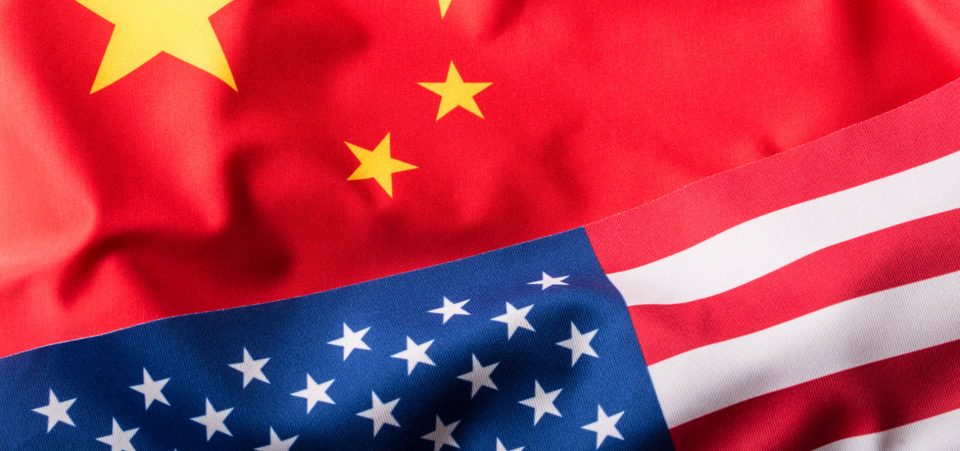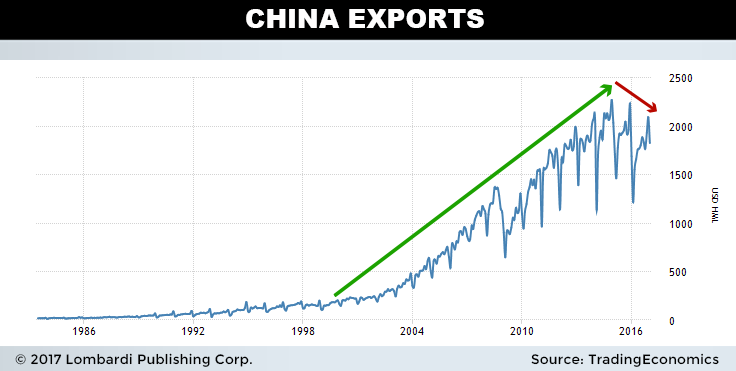Trade War with China More Bark Than Bite, But Opportunity Abounds
It doesn’t look like the great Trump China trade war is going to happen—at least with the voracity Trump’s rhetoric once implied. The threat of massive import tariffs and “currency manipulator” tags are fading quickly. It appears the horrible economic realities of a trade war with China would be too much to bear. But that doesn’t mean prescient investors anticipating this fact won’t be able to profit, even if the populists are up in arms.
It appears some already have.
Nowhere is this fact more evident than in the share prices of U.S. steel makers, which could be described as the “leading frontier” of U.S. China trade issues (steel dumping, for example). Invigorated by Trump’s November 8 victory and promises to protect American manufacturers with import tariffs on foreign goods, the share prices of steel makers went bananas. United States Steel Corporation (NYSE:X) rose 53.67% in ten trading days post-election; Olympic Steel, Inc. (NASDAQ:ZEUS) rose 46.62%; AK Steel Holding Corporation (NYSE:AKS) climbed 46.45%. Investors anticipating this trend made out like bandits.
The media served up Trump’s firebrand trade narrative on a silver platter and the markets loved it. In fact, it was the basis of the great “reflation trade” that saw all major U.S. equity markets smash records with stunning regularity. Trump’s intentions were, for all intents and purposes, treated as fact. The problem is, the markets might have been putting the cart ahead of the horse.
Steel makers since the beginning of the year have done a complete reversal. They have been among the worst performing sectors in the market. Enormous gains mentioned above have since evaporated, and then some. U.S steel is down 11.86% after the ten trading days post-election; Olympic steel down 34.84%; AK Steel Holding shed 22.94%.
So why did market sentiment change so abruptly? Perhaps it’s the mixed signals coming out of Washington. It’s as if the market has finally seen through the rhetoric and expects the status quo on China trade to remain. The evidence is mounting that this assumption may be correct.
The latest comes during the highly anticipated Trump meeting with Chinese president Xi Jinping at Trump Mar-a-Lago resort in early April 2017. Far from the nasty messaging perpetrated for months on both sides, the meeting was quite cordial by most accounts. Both presidents re-dedicated the effort of forging new bilateral and mutually beneficial trade agreements. Both seemed to recognize their strategic alliances were bar-none the most important in the world, and damaging these ties could spell economic disaster for both nations. Trump even described his relationship with President Xi as “outstanding.” That’s quite an about-face.
America has even received some unexpected help when it comes to dealing with persistent nemesis North Korea. The U.S. and China have agreed that North Korea’s provocative nuclear program cannot continue. China has even threatened to take out North Korea’s nuclear facilities themselves if the saber rattling continues. This kind of cooperation would have been unfathomable just one year ago. (Source: “US, China agree ‘provocative’ nuclear program cannot continue, Trump adviser says,” ABC News, April 16, 2017.)
So if anything, it appears ties are strengthening between the two nations, not degrading. The early Trump trade policy of imposing import tariffs on all goods coming into the United States to force the chronic trade deficits lower is looking more like a pipe dream. It’s looking more like the rapid deteriorating of trade most likely will give way to a moderate outlook and renegotiation of industry trade on a bilateral basis. Both countries played chicken, and lost.
In fact, the whole “reflation” narrative itself is taking a hit, with more investors expecting the status quo to maintain. 10-year bond yields have given up most of their post-election gains, as has the U.S. dollar. As mentioned, trade-sensitive steel stocks are now significantly lower on the year, as are retailers. Copper prices and miners are treading lower. The evidence is clear—the markets are telling us the trade war with China is mostly bull.
Few Trump critics will be very surprised by this fact.
What Is at Stake for U.S. in a Trade War with China
In the beginning, the Trump trade policy was fairly straightforward: impose import tariffs on all goods coming into the United States, and force chronic trade deficits lower as a result. The biggest question is whether only U.S.-based companies making goods abroad would be subject to the tax, or everyone. The possibility of the latter had the world’s biggest exporting nations, like China and Germany, trembling in fear. If the world’s biggest consumer market made trade more restrictive, their economies would suffer greatly.
China, in particular, has everything to lose. They cannot even reach “official” growth numbers as it is. With the benefits of globalization slowly dissipating after two decades of gangbusters growth, China sees the writing on the wall. President Xi has signaled that China will no longer target an official growth number, and is downplaying the fact growth will sink to multi-year lows. A trade war with the world’s No. 1 consumer market is the last thing China needs, with a looming debt crisis and worker’s revolt bubbling just under the surface.
The U.S. is not without its share of risks if a trade war with China erupts, however. Although the Chinese have been net sellers of Treasury securities through 2016 to shore up the yuan, they remain the second biggest holder in the world. Strong Chinese purchasing has allowed the Treasury to issue debt at very low interest rates for many years due in part to Chinese demand. U.S. China trade relations would deteriorate in any major trade war scenario, making future Treasury purchases less likely. America cannot afford fewer purchasers of their debt with the massive amount of future debt issuance on the horizon.
Top 5 Foreign Holders of Treasury Securities (in $ billions)
| Country | December 2016 |
| Japan | $1,090.8 |
| China (mainland) | $1058.4 |
| Ireland | $288.2 |
| Cayman Islands | $263.5 |
| Brazil | $259.2 |
(Source: “Major Foreign Holders Of Treasury Securities,” U.S. Department of the Treasury, last accessed February 17, 2017.)
Then there’s the matter of how much China trade means to the economy. U.S. China Trade Statistics tell us an estimated $659.4 billion in U.S. goods and services trade with China changed hands in 2015. That’s almost four percent of the entire gross domestic product of the American economy, and growing. With Trump’s four percent growth objective under the microscope, even he knows attaining this would be impossible if a trade war with China takes hold.
A Trump trade war with China would also threaten price stability for U.S. consumers. Those everyday consumer electronics American purchase, like toasters, TVs and “iPads” are all made in China. Slapping 35% tariffs would simply mean tapped-out consumers would be left footing the bill, and this would hamper retail sales even further. Retail sales are already reeling, having already suffered an additional 38,464 announced jobs cuts in April 2017. Raising prices inside the store is not the remedy to turn this trend around. (Source: “US job cuts jump 17 percent in March, but the total is lower than last year: Challenger report,” CNBC, April 6, 2017).
So if we believe the signals emanating from the market, how do we profit? By understanding which sectors will continue to do well and which will continue to suffer under a status—or even expand as bilateral agreements get forged. After all, just because Trump is going to pull the nuclear lever on trade, it doesn’t mean the trade balance won’t even out. For that to happen, China will likely need to open up their domestic market more to some U.S. industries.
For example, one of the concessions China might grant is to open up the marketplace for financial services, which is quite controlled. With a banking system with at least $6.0 trillion in bad debt (and probably more) China might be happy to allow U.S. firm to gobble up the mounting corporate debt on its books. This could be the trojan horse the Americans wish they had avoided.
U.S. auto makers are another industry which receives unfair treatment presently. China slaps a 25% tariff on U.S. car imports China, but not vice versa. Opening up the Chinese auto market could ease the sting peak auto sales will impose in the industry. There’s approximately $1.6 billion people living in China, and still the wide majority do not have cars. The market potential is still expansive.
However, the status quo will likely mean American manufacturing continues to suffer under a Trump presidency, much to the chagrin of flyover America. These U.S. China trade war predictions are further enhanced by the continuous flip-flops dogging the administration. This portends quite poorly for broad swaths of the market, from steel makers, to industrial stock to agricultural producers. A few rays of light exist, but not enough to squelch to incredible business optimism sweeping the nation since the U.S. election. Politics wins out again.
In the end, trade hawks won’t be especially pleased with the results, but investors playing the unwinding of the reflation trade might be. Half of America truly hoped the Trump rhetoric was different, even if a trade war with China meant higher inflation and other hardships. But it appears the globalist Goldman Sachs wing of the White House is winning the war, with the “America First” crowd slumping to the corner in defeat.
America, meet the new boss. Same as the old boss.







